
काठमांडौ फीनिक्स
Kathmandu Phoenix
Notes for a Redevelopment Masterplan
[ KP in pdf ]Drafted by Seth Sicroff for Mountain Legacy
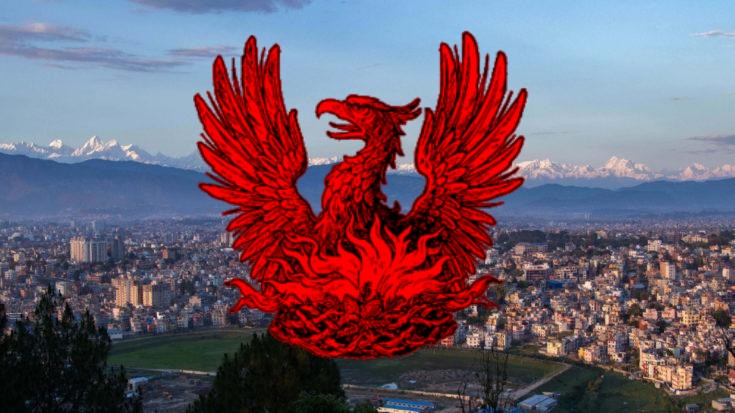
Note about the photographs in this document: Many are borrowed provisionally without permission from online sources.
If any of the images are yours and you want them removed or credited,
let us know and we will make the necessary adjustments.
Introduction
About this document (disclaimers and limitations)
Kathmandu Phoenix is at present not a project, or even a project proposal. It is a concept, a conversation starter, specifically intended for consideration by the Nepal Tourism Board, with the understanding that implementation of any version of this scheme would necessarily involve participation by municipal, provincial and national authorities and agencies.
Rationale
With so much of Nepal’s economy effectively stalled, there is an opportunity to undertake an ambitious reset of the tourism industry. The changes proposed would put Nepal in the forefront of efforts to resist climate change and at the same time to beautify and humanize the urban environment. As a city in Nature (not an artificial garden city or a city of gardens), Kathmandu would proclaim its solidarity with the larger environment, with the diverse communities and ecosystems stretching from the Gangetic plain to the peaks of the Himalayas. This sort of project should attract collaboration and support from a wide range of international organizations.
Part of our remit as tourism planners is to observe the trajectory of political conditions that may impinge on expenditures both by tourism consumers and by developers and funders. Although we are currently in the depths of a near perfect storm of disasters, we know that the storm will eventually abate and we will be able to continue as before. However, we also know that the political tides are turning. We will have defeated the terrible pandemic. Tourism will revive. Trump will be gone. A new spirit of optimism, international collaboration, and determination to shape a more sustainable future will seize the planet such as we have not seen for many years. Nepal needs to position itself as the flagship of a new Earth First! movement.
As a recognized "last best place on Earth" Nepal deserves the best efforts of the global community to sustain, conserve, and enhance the natural and cultural legacies within its borders, and also to serve as a model of stewardship for other nations battered by problems that they neither created nor are capable of overcoming on their own. Kathmandu is an appropriate place to join forces against insouciance, helplessness, and greed.
Focus on "Western" tourism
Tourism is likely to remain a substantial part of Nepal’s economy, and certain to offer the quickest route to sustainable opportunities and stewardship in the remote mountains. We are aware that the largest contingent of tourists in Nepal is arriving from India, and Chinese tourists are also increasingly numerous. Domestic tourism is still a trickle, comparatively, but if one includes day-trips, or overnight stays, the number of visits is certainly not negligible, and it is expected that the volume of domestic tourism will grow strongly in the near future. However, these notes focus primarily on international tourism arriving from Europe, the Americas, and Australia.
Although the project proposed here concerns comprehensive change in Kathmandu Valley and would impact the lives of millions of Nepalis every day of the year even more intensely than it would affect tourists for the relatively short period that they spend in Kathmandu, the proposal is being addressed to the Nepal Tourism Board, and it is therefore elaborated from the perspective of what can be done to optimize tourism. The proposal should not move ahead unless there is corroboration of the expectation that the changes would be beneficial to all stakeholders, especially to Nepalis living in or visiting Kathmandu.
Targeting the primary gateway
One further limitation of this proposal is that it is focused on Kathmandu, as the primary gateway for long-distance international tourism (as opposed to arrivals from India and China). The charisma and challenge of the mountains draw tourists to Kathmandu (and to secondary gateways such as Pokhara and Namche Bazar); the appeal of those gateways also enhances or diminishes the draw of the mountains. Both are critical factors, and must operate synergistically.
First impressions shape recommendations
As indicated in the graphic below, 38% of tourists choose their destinations based primarily on the recommendations of friends and relatives, and 22% on the basis of information on the Web other than advertising: that means 60% of "marketing" is based on the impressions and experience of travelers. As with all complicated and intense experiences and relationships, first impressions play an outsize role. So we must ask, What do tourists see when they step off the plane in Kathmandu? What will be the topics of their first emails or Instagrams? What snapshots will they share? Which emojis?
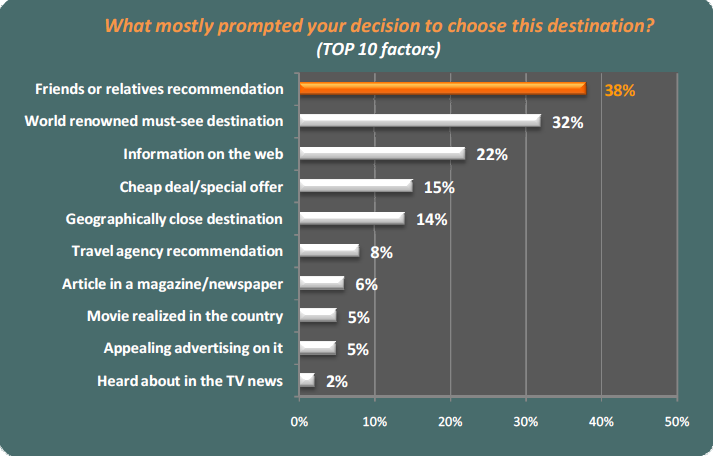
Top factors influencing destination choice according to TravelSat
Of course, positive first impressions need to be supported by ensuing experiences, which is why it is not enough (for instance) simply to embellish the arrival area at the airport and attenuate the frustrations of the chaotic taxi services.
Nepal Tourism: It’s about Happiness
The satisfaction of tourism consumers in Nepal has traditionally been linked explicitly to the happiness and friendliness of the hosts. That perception in the mind of Westerners may be traced to Shangri-La or to the devotion of Ed Hillary to his Nepali friends. The genuine hospitality and tolerance of the people, the interested camaraderie of the sadus, the friendliness and integrity of the expedition crews, and the general good vibes (all of which may have featured more strongly in the minds of the guests than in those of the hosts) transformed Nepal into a sort of nirvana at the end of the overland Hippie Trail.
Attitudes change, of course, and it is to be expected that tourists will wear out their welcome, as the novelty of their odd appearance and admiration for their apparent idle wealth dissipates. For now, despite everything, the exceptional hospitality and good will Nepal’s people are still essential to her tourism industry. The friendliness, energy, and integrity of hotel personnel, shopkeepers, guides, and other service providers all inspire trust and friendship: these are the first impressions that set the mood for a trek or expedition, and they (more than the adventure itself, which may in fact be grueling or even tragic) result in word-of-mouth referrals and return visits.
But happiness is a delicate brand. The people must feel happy and hopeful about their government, invested in their mountain legacy, and tolerant of the invasion of privacy inflicted by even the most considerate tourists. An ambitious program of renewal, with key goals that address issues of opportunity and equity, can go a long way toward strengthening prospects for future tourism expansion.
The point here is that we are dealing with a conjunction of interests: the satisfaction of tourism consumers can be augmented through measures that also augment the happiness of tourism providers and host communities. Those that can be characterized as urban redevelopment are addressed in Part 1. There are other measures that need to be taken to improve the welfare of Nepalis that could not fall into the ambit of tourism planning, such as improved education, enhanced economic opportunities for women, enforcement of laws regarding caste and ethnic discrimination, and so on, and these are not addressed substantively here. There are also factors that bear on the convenience and satisfaction of tourists more than on that of the host population, and some of these are addressed in Part 2.
PART 1: Toward a Biophilic City
While there are clearly many aspects of Kathmandu that are attractive to tourists, there are many factors that could be improved.
The problem
The condition of Nepal's capital has not escaped international notice.
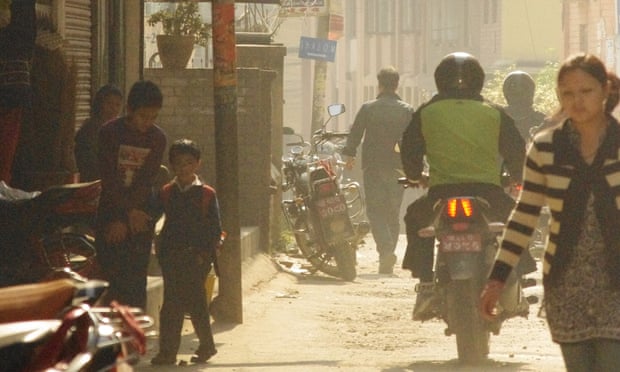
Nepal ranked 177th out of 178 countries for air quality in the 2014 Environmental Performance Index.
Sick Cities: Has air pollution made Kathmandu unliveable? Photograph by Sara Germain, The Guardian, March 21, 2014
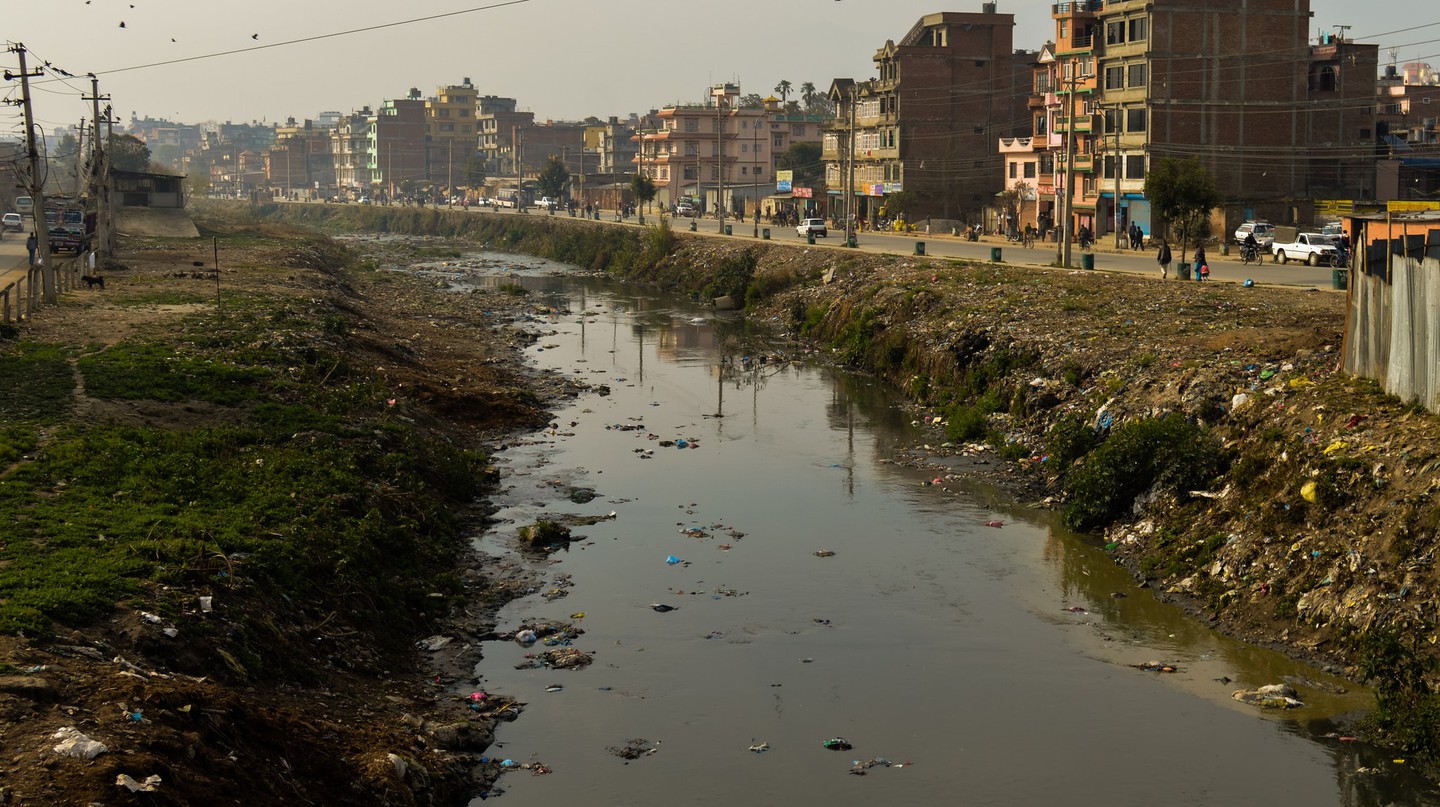
Why is Kathmandu in the Midst of a Pollution Crisis? by Elen Turner; Culture Trip, 20 September 2018
Floods, landslides after monsoon rain kill dozens in Nepal (Al-Jazeera)

Mount Everest Visible From Kathmandu For The First Time In Decades by Priya Pareek, RepublicWorld.com 20 May 2020
These are the facts of daily life in Kathmandu that leap to the attention of the arriving tourist:
- Traffic, smog, and dust
- Poor road conditions result in slow, jolting rides within most of Kathmandu, and much worse when you when you leave the valley
- Filthy rivers
- Unsafe tap water
- High incidence of gastro-intestinal disorders, including roundworms, tapeworm, bacterial and amoebic dysentery, giardiasis, Hepatitis A and E
- Ugly treeless streets, stalled construction and restoration projects, piles of construction materials, hazardous pits in sidewalks and streets; tangles of telephone lines; lack of sidewalks in many areas
- Obtrusive and discordant billboard advertisements, including numerous promotions of cigarettes
- Beggars, including wandering ascetics, homeless families, and individuals with horrendous diseases such as elephantiasis and leprosy
- Stray dogs, often in excruciating condition: starving, mange-ridden, broken limbs, suppurating injuries and disease; high incidence of rabies
- Lack of decent toilets in public facilities
- Lack of suitable jogging routes or exercise facilities
- Periodic shortages of petrol (gasoline), resulting in waits of many hours at the few filling stations
- Monuments in poor state of repair
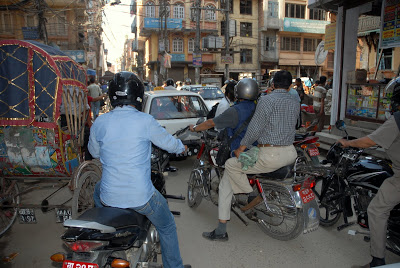
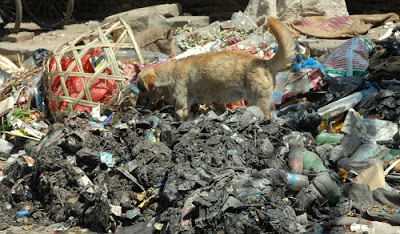
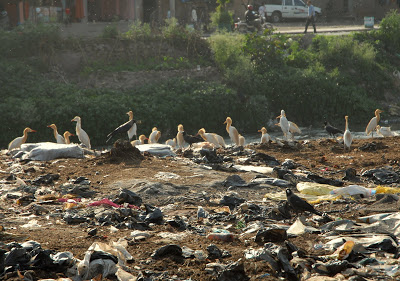
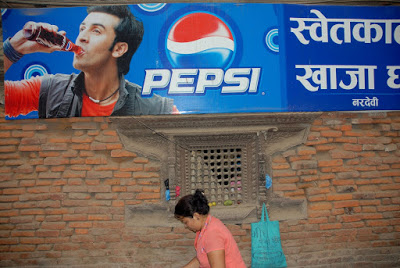
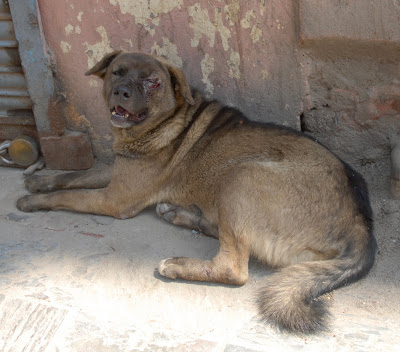
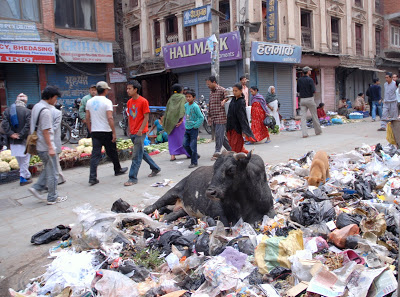
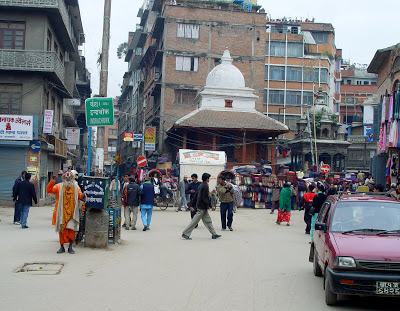
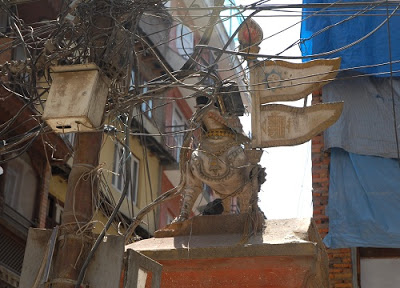
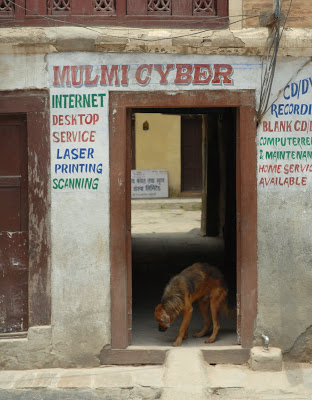
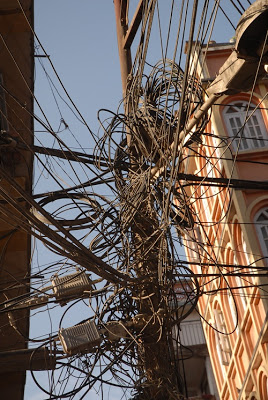
Some of the above features of Kathmandu life entail mere inconvenience or a negative aesthetic response from visitors, but these should be taken seriously, if only in view of the importance of word-of-mouth travel advice or reviews shared on the Internet. Others entail health hazards that could completely derail a visitor’s tightly choreographed agenda. Many people come intending to spend a day or two in Kathmandu and then depart on trek; if they get dysentery, they are likely to miss the trek; worse, if they catch something in Kathmandu which manifests a few days later when they are away from modern health facilities, they may require costly evacuation, or they may miss their flight home.
From the local point of view, as well, some of these issues may be inconsequential, while others are burdensome. Here is a short list of current environmental concerns that impact Kathmandu residents:
- Despite many progressive developments (including restrictions on diesel consumption, introduction of electric vehicles, decline in prevalence of cigarette smoking, and banning of single-use plastic bags), Kathmandu is an unhealthy place to live. In 2017 Numbeo ranked Kathmandu as the 7th most polluted city in the world, taking into account air and water contamination.
- Bacterial and parasitic diseases may not appear to impact locals as much as tourists, but they have serious consequences. Dysentery is still a major cause of death. Comorbidities raise the stakes in the case of new epidemics, and the overuse and misuse of antibiotics and other therapeutics is training superbugs, which will inevitably impact not only Nepal but the entire world.
- Traffic, fuel shortages, strikes, and other issues raise stress and cause deep-seated dissatisfaction.
- Exercise facilities are largely lacking; jogging on public streets is hazardous.
- Inadequate waste management facilities
- Annual monsoons bring flooded streets and houses, causing inconvenience, infrastructure damage and death. Mold and mildew deface building exteriors and aggravate respiratory issues
- The impact of global climate change in Nepal is palpable, and a notable stressor in the lives of young people, who face predictions of cascades of disaster.
- Although some young Nepalis have taken to frequenting Thamel dance bars and restaurants, the current recreational and tourism center of Nepal is a cultural irritant due to late-night noise, crime, traffic and inflated rents.
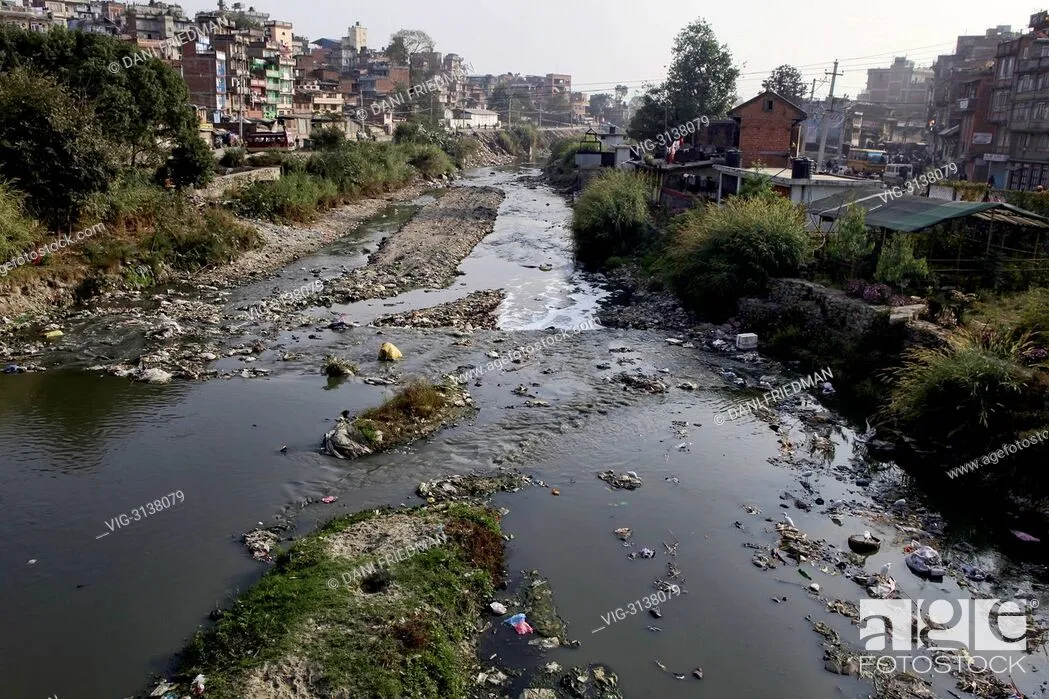
The Bishnumati River, west of central Kathmandu. Cleanup efforts are ongoing, so current conditions may be better.
The alleviation of many of these problems could be achieved through the rebirth of Kathmandu as a "biophilic city," designed to harmonize more with the natural environment and also to mitigate the damage that humans are causing to our biosphere. That would entail widespread planting of trees and other greenery along streets, on and hanging from overpasses, and in new parks and public spaces; cleaning and beautification of the waterways; rethinking of transportation; ground-up development of waste management; overhaul of the water supply system, and other sub-projects. What follows is an unordered laundry list.
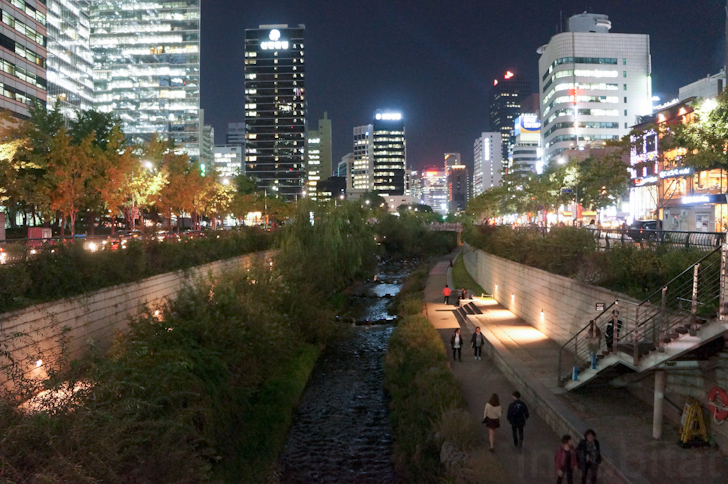
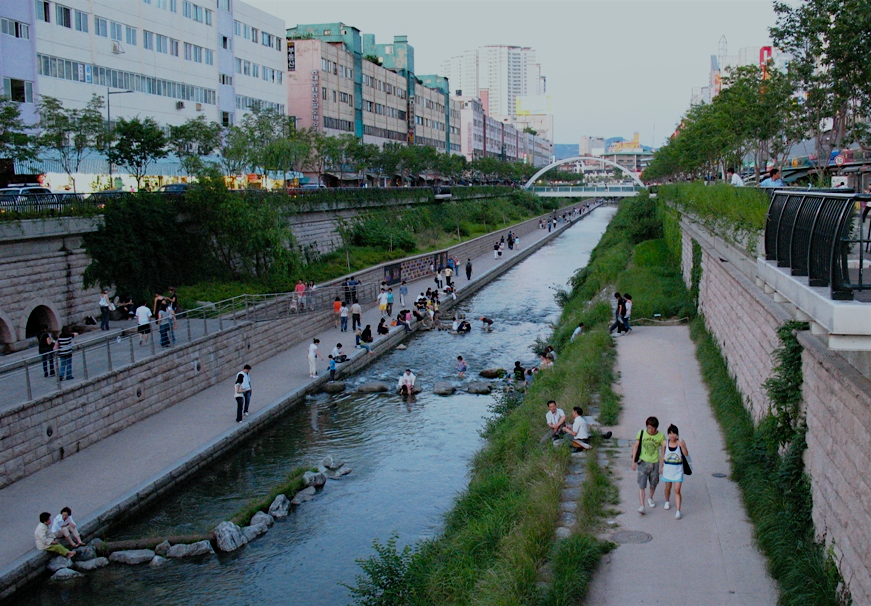

A couple of successful waterfront rehabilitations: Cheongycheon Creek in Seoul (left and middle) and Baltimore (right)
- Clean up all the rivers
- Although Kathmandu has no natural waterfront on the scale of 'Baltimore's (above left), a more mature recreational and tourism center could be developed along the Bishnumati
River west of Thamel, somewhat along the lines of the Cheonggyecheon Creek restoration in Seoul (above right).
- Develop new recreational and touristic center on Bishnumati, west of Thamel: natural greenway, upscale shops, restaurants, cafes, and other attractions; it may be necessary to regulate year-round flow by means of a reservoir north of Shivapuri
- Build a world-class conference center/auditorium bridging the Bishnumati, with a glass floor in order to view the river below.
- Promote river sporting events
- Support and/or introduce endangered species (vultures, gangetic dolphin, red panda, pangolin?)
- Greenery should be planted everywhere: tree-lined streets, hanging gardens on overpasses, flowers in windows. Rhododendrons, bougainvillea, and marigold are important branders of Nepal tourism. National tree-planting day (sometime in July?)
- Protect the hanging trees of the enormous fruit bats in Lazimpat (central Kathmandu), but also protect pedestrians from their droppings. http://www.evotis.org/fruit-bats-kathmandu
- Only electric motors should be allowed within Kathmandu Valley. Due to the topography, the basin frequently traps a thermal inversion layer, or inversion dome, which aggravates air pollution. Diesel and petrol should be quickly phased out. No personal cars allowed within the city -- must be parked in satellite facilities. No horns. Strict load limits on buses, trolley, and other conveyances. With reduced petrol usage and stringent emission standards, mountains would be visible year-round.
- Establish mass transit of some sort between city and airport. Taxis are inefficient.
- From Jhocchen/Madan Tole to Basantaphur to Seven Corners in Thamel: pedestrian and rickshaw only. Paved in cobble stones or brick. Also Pie/Pig Alley and Dhobi Chaur, and other streets leading from city core to Vishnumati.
- Eliminate landline telephones. Remove all above-ground wires (including electric) and place below ground alongside sewage and water distribution.
- Expand the park system. Recover the Indian embassy estate and turn it into a municipal park. The underused Tundikhel parade ground could be converted to a grand natural park, exhibiting indigenous ecosystems and species, with visitors restricted to board-walk paths (which may ascend into the canopy), with interactive displays throughout. A scale model of Evierest should be erected in the center of the garden; like the model at the International Mountain Museum in Pokhara, it should be climbable, offering routes of varying degrees of difficulty.
- Repair streets, lay out sidewalks where there are none and convert narrow streets to pedestrian-only zones
- Reinforce Nepal’s traditional model of urban design
- Preserve the ancient toles (neighborhoods) centered around chowks featuring temples and stupas. (Increase security for valuable art.) Pedestrian access only.
- Bring World Heritage Sites into compliance with UNESCO stewardship guidelines on all details, including inappropriate development on east side of Hanuman Dhoka.
- No buildings over 6 stories high. Temples must be allowed to dominate skyline, and mountains must be visible from downtown.
- Limit dust from construction. Pave roads quickly. Surround building sites with plastic flexis (banners) with artistic themes
- Make Kathmandu a dog-friendly community
- No consumption of dog meat.
- All dogs should be neutered except those owned by professional breeders.
- Street dogs must be rounded up, homed or placed in sanctuaries.
- High profile dog shows should be held.
- Facilitate travel with dogs.

Editorial: Tundikhel in its entirety should be open for public use Friday, June 26, 2020
Cleanup efforts are ongoing, so current conditions may be better.
PART 2: Expanded Opportunities
Although tourism has expanded over the years in terms of the number of arrivals, the contribution of this sector to the national GDP is not great: 7.9%, barely more than in the USA (7.8%) and substantially less than countries such as Portugal, Morocco, and New Zealand, where the contribution is around 17%. Obviously there is room for growth, bot in visitor-days and (more important) in expenditures per visitor per day. Here are some ideas.
Facilitate Air Travel from the Origin
A critical bottleneck for tourism in Nepal is the flight itself. Flights are expensive, long, cramped, and sometimes difficult to book. Prolonged layovers in Doha, Dubai, and other Middle Eastern hubs are unpleasant and costly. Solution: direct charter flights from key origin points (USA, England, Germany, Melbourne). It would probably be better to arrange charter flights, with no baggage limit on the return flight (in order to encourage shopping). Offer more leg-room and undercut the major airlines’s fares, even if it means losing a bit of money.
Update visa procedures
Nepal's visa policy has had two goals: to limit the presence of undesirable foreigners, and to raise money. For some time, the visa renewal process was also used as a stick to force foreigner to change money at legal exchange facilities, which were disadvantageous both in terms of convenience and also the rate of exchange, as compared to the unofficial money-changers operating in Thamel, Freak Street and other places where tourists congregated. Although the interruption of the overland hippie bus trail greatly reduced the attraction of Nepal as a youth hangout, there was still an effort to stymie budget travelers (who often came to trek and stayed longer than other tourists) and to favor quality tourists, who spent more per day but moved on more quickly. This focus persisted despite the documented fact that the overall economic impact of budget tourists was much more beneficial to Nepal than that of the luxury tourists: budget travelers spend more in-country, with less economic leakage, and their purchases are more likely to trickle-drip into the existing local economy than those of luxury tourists, who tend to patronize enterprises that develop purely to service the tourist sector. Our view is that a mix of tourism types would provide the optimal economic boost for Nepal's economy. (See Independent backpacker tourism: key to sustainable development in remote mountain destinations ).
Our suggestions for more productive visa policy:
- Accelerate passage through the airport and reduce manpower costs for Nepal by encouraging tourists to acquire visas prior to arrival. That could be done by charging substantially more for visas purchased on arrival. If the 30-day visa cost $100 when purchased prior to departure but $200 on arrival, the lines (and waits) in the airport would be negligible. Visas should be available online: a prospective visitors could apply and pay by app, and then print out the visa and glue it in passport. (If special visa paper is required, the visa could be mailed.) Note that $100 seems like a trivial expense when one is still at home, paying thousands for flight, equipment, hotel bookings and other expenses.
- Restructure the fees, which are currently designed to depress the length of visits. Solution: one fee for a stay of up to 6 months, or perhpas even a year.
- The visa should cover all park entrance fees. We know that people avoid Hanuman Dhoka because of the 1000NR charge to non-SAARC tourists, which is applied in an apparently racist manner. If you appear to be white, they [try to] stop you. If not, they let you go. Park funding should not go to personnel who only have the job of hassling tourists, but have no ability to help visitors. The current system also discriminates against businesses inside that area.
- During pandemics such as COVID-19, ban non-essential visits from countries with high rates of infection (currently, US and Brazil). Require Health Visa and pertinent tests prior to visa application and on boarding flight to Nepal.
- Require travel insurance, with evacuation coverage. That should be mandatory anyway -- it is not safe to have tourists who can't be helicoptered out if they get sick or injured.
- Require that every tourist have a functional mobile phone, with local SIMM. That way they can be tracked (eg in case of COVID exposure), notified of general emergencies, and assisted in case of personal problems.
- NTB could have a detailed app that would accept advertising (and money) from local businesses. Tourists could be requested to fill out a detailed survey, asking about their experiences (positive and negative) for each site they visited, and for general conditions, as well as asking them to opt into a May Day system, whereby Nepal can request aid in the event of a new disaster.
Lobby for longer vacations
Most Europeans get four weeks of vacation, but two weeks is the standard in the United States. Many Americans don’t have enough vacation time to spend three weeks on a longish trek in Nepal, such as Everest Base Camp. Nepal should take the lead in asking the UN to declare that 4-weeks’ annual vacation is human right.
Improve Access to Airport
- Facilitate arrival and departure by means of a bus shuttle serving Thamel Chowk, Hanuman Dhoka, Durbar Marg, and certain points in Patan.
- Taxis are currently very cheap in Nepal, but the situation confronting new arrivals is intimidating: no meters, vigorous touting, no basis for trust. Fares should be based on a map-quadrant system, and calculated by counting the quadrants traversed, with tota farel adjusted for time of day, extra baggage, number of passengers, etc. A cheat-sheet should be available at airport and information kiosks, and on a mobile app. With standardized rates, the entire schedule can be ratcheted up to bring taxi fares more into line with modern reality.
- Reduce dependency on TIA by improving highway between Pokhara and Kathmandu. There is no reason why a displacement of 200 km (125 miles) should take 6 or 7 hours. Aim for 3, which would make bus travel competitive with air travel.
- Reconsider the location of TIA. The new prospective hub, Nijgadh International Airport (planned for 2025), is a step forward, if it substantively replaces TIA. Having any airport within city limits is hazardous in case of accident; raises the burden on local transportation services; and increases pollution (particularly due to the thermal inversion that is typical of the entire Kathmandu Valley. In case of earthquake, TIA is especially vulnerable, as it lies on a deep layer of lacustrine deposits, which tend to amplify seismic waves (as in Mexico City) or even liquify; the result could be incapacitation of the sole means of emergency access to Nepal’s largest population center, as well as its most important port of evacuation.
Defeat Seasonality
Nepal must not be held hostage by the monsoon.
- Tourist and shopping areas should have elevated and colonnaded walkways to permit activity during the rain; Asan Tole could have a removable canopy.
- Improve drainage and sewer system
- World class events, such as a “Back-to-Nepal” season-opening music festival, should be scheduled in late August. Rock-n-roll dinosaurs of the 70s as well as other big name acts should be brought in, not only to perform their own classics, but to jam with Nepalese musicians. If this event could be held in a weather-proof venue, Nepal would be able to expand the high season by a couple of weeks.
Focus on education
Education develops tourists for life. International students will return repeatedly, and bring family and friends.
- International study should be destination based, not organized by outsiders. International students should be offered special programs at Nepalese universities, integrated with Nepalese students and researchers.
- Offer Nepali courses free of charge. People who learn the language will return repeatedly in order not to have wasted their investment.
- Promote cooking, yoga, crafts, and other courses
- Establish Disaster Management University. Convert the underused Narayanhiti Palace and grounds to a cutting edge international disaster management research university, with an affiliated campus at the International Mountain Museum in Pokhara. Also repatriate Phora Durbar (the U.S.Marines’ country club opposite Narayanhiti) and use it either for DMU students or for a public recreational facility.
Imagery is vital component of marketing
An essential aspect of marketing must be the imagery. A vibrant movie industry that exports narratives set against the backdrop of Nepal's extraordinary landscape could be helpful. Tourists and professional photographers need to be able to shoot attractive images, unencumbered by unsightly tangles of wires, rubbish, suffering street dogs, desperate homeless people, open street pits, untended piles of sand and gravel, mouldering paint, and garbage-clogged waterways. The first impression of an arriving tourist should not be that of a treeless urban desert, jammed with unmoving taxis, sweltering in the inversion dome of smog and dust that completely obscures the famous mountains.
Expand street art and other sights
- Nepal is well-endowed with authentic historical monuments, but these tend to be limited to a few sites, which these days are roped off and open only to those who pay admission. Much of the city is impersonal and unresponsive to tourists. The amount of money raised by such blocades such as those at Durbar Square in Kathmandu and Durbar Square in Patan is trivial. It would be much better to raise the visa fee a bit, and stop charging for visits to historic zones. This is especially important inasmuch as the multi-level pricing system, which strikes many visitors as blatantly racist.
- Tourists want selfies in front of world-famous icons. There should be statues of Ed Hillary, Tenzing Norgay, Junko Tabei, and Reinhold Messner right at the core of the tourism district, positioned for shots that will include other key assets -- for example, the new Kathmandu Phoenix Convention Center.
Develop Thamel as a modern redlight district
Experience in many tolerant communities (such as Amsterdam and Copenhagen) has shown that legalization of formerly criminalized activities has a cascade of benefits. Prostitution and drugs can be licensed and regulated, protecting purveyors and consumers. Health and sanitation standards can be raised, thereby protecting not only the local community but also the home communities of participating tourists. The entire phenomenon can in effect be optimized to protect traditional values and also enhance Nepal’s brand as a tolerant and forward looking society.
Dancing at loud discos, ganja smoking, and other marginal behavior should be legalized and tolerated, with some regulation. Cannabis was only made illegal in the 70s due to American pressure; as current trends worldwide are toward legalization of marijuana, Nepal could recover its position as a leader in recreational and medicinal cannabis. A leading cannabis researcher at Cornell has expressed interest in collaborating with Nepalese experts.
Shopping and Commercial Opportunities
Shopping is one of the most important tourism attractions and needs to be facilitated. At present, many people do little shopping for the following reasons:
- They are afraid of being cheated.
- Baggage restrictions make most large or heavy purchases impractical.
- They don’t trust merchants or shippers to actually get their goods to them intact.
- US Customs (for instance) grants duty-free import of purchases up to $800. Even if the Customs turns out to be a negligible amount, any declaration is likely to mean that you can’t go through the “green line”: an unpleasant way to end a long trip abroad.
Solutions:
- Prices should be fixed, and posted prominently. Content/composition of items must be clearly defined, subject to government testing.
- Government should support high-value arts and crafts: pashmina, bronze sculpture, thangka painting, carved-wood furniture.
- Medical and dental tourism should be longer term goals.
- Focus on ecotechnological products: CBD, ethnobotany, pharma
- Pashmina should be big business. Fund a coffee-table book, as well as an Institute of Pashmina Art (to teach home-base subcontractors how to embroider, bead, paint, jacquard, fringe, and otherwise customize the somewhat boring plain-Jane shawl).
- Promote Nepal through stamps -- oversize, high-res pictorials and commemoratives. Even though there is essentially no postal service in Nepal (due, partly, to the absence of street signs and house numbers), tourists can still send postcards home to their friends. Nepal government should facilitate delivery of first day covers and other collector specialties.
Trekking Development
- Trekking is very much like marathoning. Trekkers want bragging rights for their accomplishments. Just as marathoners collect “finisher’s medals” (which are handed out to everyone who finishes), trekkers should have an opportunity to collect trek (peak) medals. NMA could monetize two products: the medal rack (eg, a wooden profile of the Himalayas, with pegs to hang medals) and peak/route medals. Especially on the Great Himalaya Trail, communities should have medals for sale commemorating the local leg. (If some communities are not set up as full-fledged pit stops, with lodges, restaurants and medal sales, they should share proceeds of trail completion certification and medal sales.) The same medal racks could be modified for international marathons and half-marathons and marketed internationally, thereby promoting the Himalayas as the ultimate challenge.
- Establish up a Sherpa Corps, partially on the model of the Peace Corps. Sherpas would enlist in order to help prospective new trekking destinations and pit stops develop and maintain control. There should be a video illustrating potential opportunities as well as dangers (economic, cultural and ecological) inherent in promotion of tourism. If a community wishes to proceed, the SC would mentor development of infrastructure and services.
- Develop domestic mountaineering tourism. Establish mountaineering clubs in colleges and universities, foster exchange trips with Indian and Chinese students.
Mountaineering
Overcrowding on Everest is bad for the reputation of Nepal tourism, and bad for the mountains. Nepal must cooperate with China to raise standards, increase fees, and reduce traffic.
- Mitigate the impact of human waste: support the Mount Everest Biogas Project
- Institute regulations requiring prospective Everest climbers to prove their readiness for Everest by completing a “ladder” of less demanding peaks.
Target International Collaborators
- Encourage the proliferation of Sister Cities, Rotary Club, Lions Club, and other orgs with international links. Hold roundtables and conferences to bring these ingos together and facilitate collaboration.
- The YMCA in Kathmandu is inchoate, yet the parent organization is very interested in serving world-wide.
- Get each departing tourist to fill out a survey, indicating areas of satisfaction and dissatisfaction, and also committing to help Nepal in case of another disaster. Collect contact information and collate responses for future planning.
International Events
Kathmandu should market itself as the go-to convention venue, particularly for issues of sustainability, disaster management, and sports-for-development and peace. With a new Disaster Management University, and a miraculous urban redesign, as well as links to major international universities, Kathmandu would be in a position to bring together all manner of specialists, from luxury hotel marketers to Rotary and Lions Club world memberships to destination wedding planners.
The Little Stuff
Nepal is part of the global community. It should be using the same calendar as its customers. And it would be helpful if it adjusted clocks to Greenwich Mean Time +6 (instead of 5 ¾).
Bring Back the Dream
Today, no less than in the 70s when Bob Seger sang Back to Kathmandu, Nepal is at the top of people’s bucket list. We need to make it easy for them to live out that dream.
EPILOGUE
Promote Partourism (Participatory Tourism)
See my articles in Wandering Educators
Bring home the diaspora
External conditions, notably the mistreatment of Nepal’s expatriate workers, may be even less tractable, and substantial improvement may depend on the ability of those workers to find well-paid jobs at home in Nepal. An expanded tourism industry would help.
Contact
Do you have suggestions or other feedback? Join the Kathmandu Phoenix Google Group. Contact Mountain Legacy Projects Coordinator Seth Sicroff at sicroff@mountainlegacy.org
511 W. Green St., Ithaca NY, 14850 USA; (607) 256-0102.